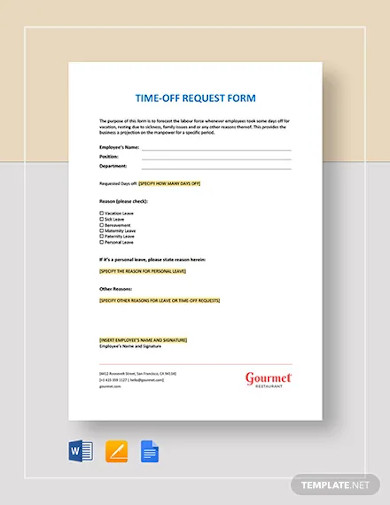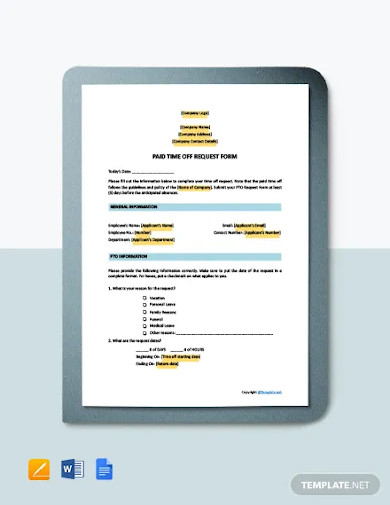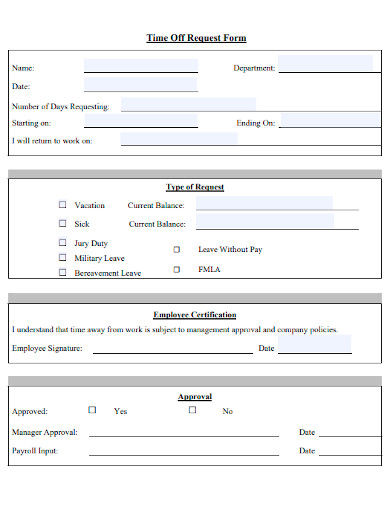The purpose of the Time-Off Request Form is to ensure that the employee record request is properly documented, approved, and recorded in the organization’s records. It is also used as a reference sample for hourly schedule and payroll schedule purposes, as well as for tracking employee absence record.
When an employee submits a Time-Off Request Form, it is essential to submit it in a timely manner, preferably well in advance of the requested time off. This allows the organization to plan for the employee’s absence and make arrangements to ensure that work is covered during the employee’s absence.
Time-Off Request Form Samples
1. Time-Off Request Form Sample

2. Paid Time off Request Form

3. Employee Time-Off Request Form
What is Time-Off Request Form?
A Time-Off Request Form is a standard document used by organizations to facilitate the process of requesting time off from work by employees. This form is an essential tool for employees to request time off for various reasons, including vacation leave plan, sick leave plan, personal leave plan samples, or family emergencies.
How To Make Time-Off Request Form?
The Time-Off Request Form is also an essential tool for maintaining employee satisfaction and work-life balance. When employees feel that they have the flexibility to take time off when needed, they are more likely to be motivated and engaged in their work. To create a Time-Off Request Form, follow these steps:
Step 1- Identify the purpose and scope of the form
Determine what types of time off the form will cover, such as vacation, personal days, sick days, and bereavement leave. Consider the different policies and procedures in your organization that relate to time off requests. You can create a physical or digital form. For physical forms, you can use a pre-printed form or design your own. For digital forms, you can use software such as Microsoft Word, Google Forms, or an HR software.
Step 2- Create a header
Add a header that includes the name of your organization, the title “Time-Off Request Form,” and any other relevant information, such as the employee’s department or ID number. Add fields for employee name, employee ID number, department, and contact information.
Step 3- Include fields for time-off request
Add fields for the dates requested for time off, the duration of the time off, and the reason for the request. Add a section for the supervisor or manager to review and approve or deny the request. This section should include a space for the supervisor’s name, signature, and date.
Step 4- Add a disclaimer
Include a disclaimer at the bottom of the form that states that the form is not a guarantee of approval and that all time off requests are subject to the company’s policy statement and business needs. Test the form to ensure that it is functional and easy to use. Make any necessary adjustments to the design or content.
Who uses a Time-Off Request Form?
Time-Off Request Forms are typically used by employees who need to take time off from work for personal reasons, such as vacation, sick leave, or family emergencies.
Why do companies use Time-Off Request Forms?
Companies use Time-Off Request Forms to manage employee absences and ensure that requests are properly documented and approved in accordance with company policies and business needs.
Can a Time-Off Request Form be denied?
Yes, a Time-Off Request Form can be denied if it does not comply with company policies or if the requested time off conflicts with business needs.
In conclusion, it provides a structured process for employees to request time off and for supervisors or managers to review and approve or deny the request based on company policies and business needs. By using this form, organizations can ensure that time off is managed effectively, and employees are able to maintain a healthy work-life balance.
Related Posts
Passport Application Forms Samples & Templates
FREE 6+ Sample Income Based Repayment Forms in PDF
Passport Consent Form Samples & Templates
Simple Will Forms
Sample Application Form Templates
Sample Employee Declaration Forms
Parent Consent Form Samples & Templates
Sample Release of Liability Forms
Sample Training Feedback Forms
Sample Sworn Affidavit Forms
Agreement Form Samples & Templates
Vehicle Inspection Forms Samples & Templates
Sample Employee Advance Forms
Sample Child Travel Consent Forms
Sample Testimonial Request Forms
